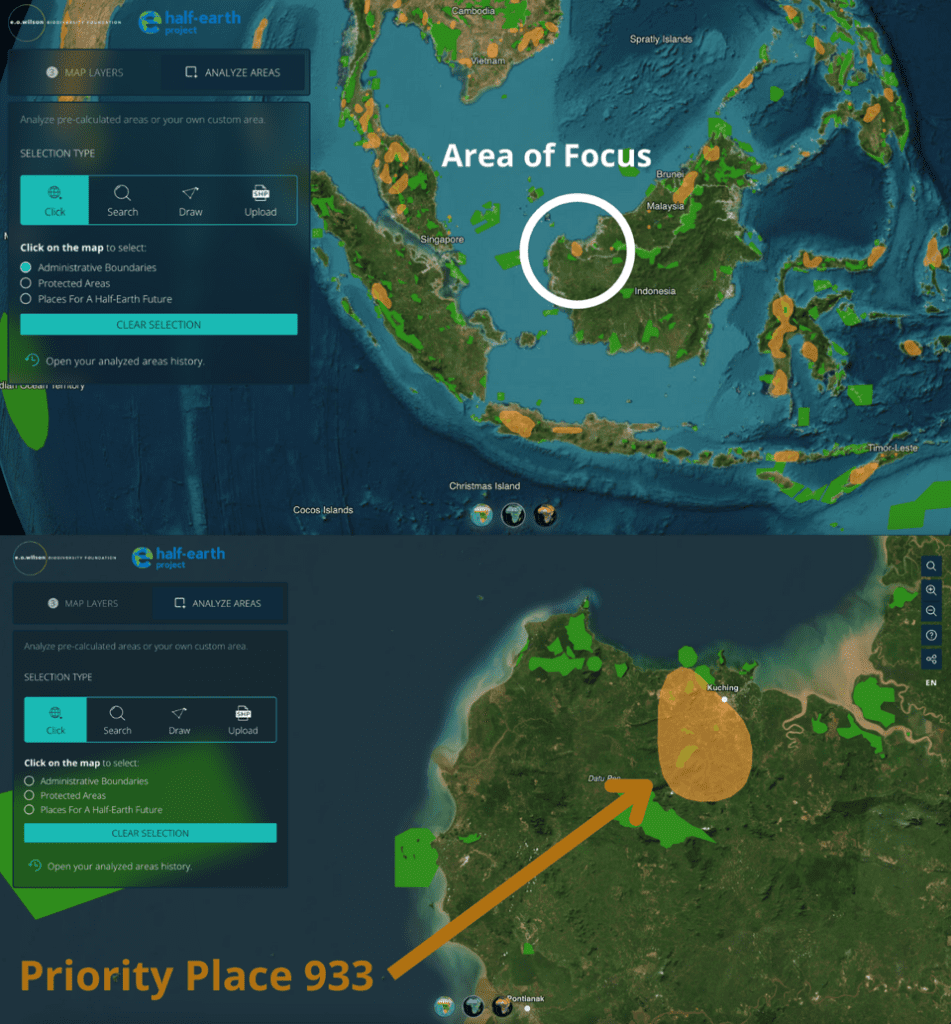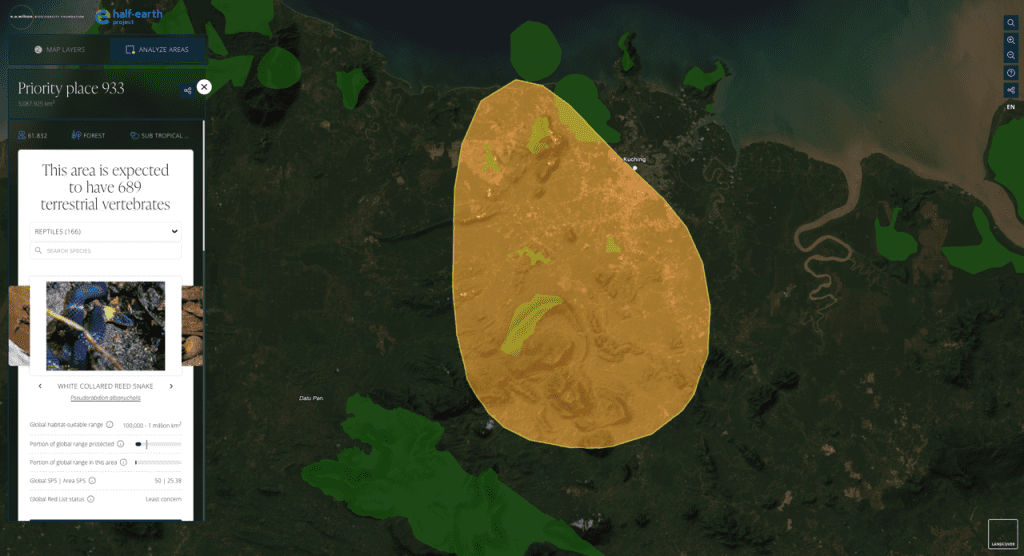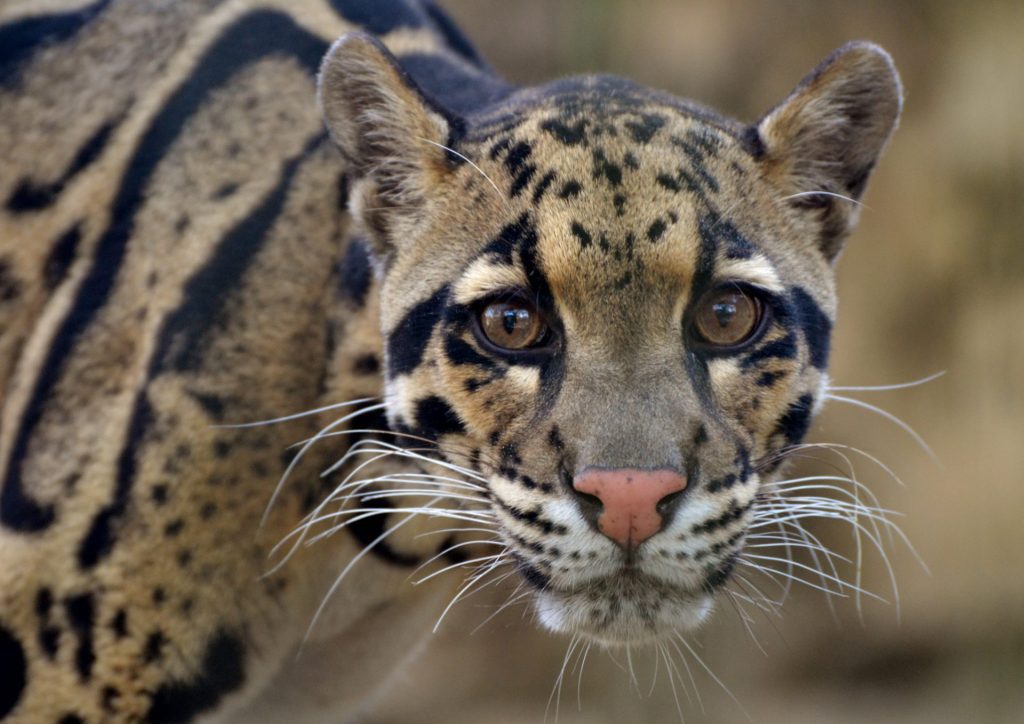Walking through the forests of West Borneo is an intense, immersive experience. The air is thick with humidity, making every breath feel heavy. The jungle is alive with sounds—chirping insects, rustling leaves, and the distant calls of birds and other unrecognizable creatures. The towering trees form a dense canopy above, with sunlight filtering through in soft, dappled patches. The thick undergrowth teems with life, from creeping vines and bright fungi, to herbaceous plants waiting for the next insect to fall victim to their trap. Listen closely and you may hear the call of the helmeted hornbill. The call starts as a series of slow, deep honks, far apart, then builds up gradually in speed, before climaxing in a loud maniacal laughter, as if the hornbill is cackling in amusement as you drudge through the jungle.


This is Priority Place 933 on the Places for a Half-Earth Future layer on the Half-Earth Project Map. Priority Place 933 straddles the international border between Indonesia and Malaysia on the island of Borneo, with a considerable part extending into the urban area of Kuching, Malaysia. This makes conservation efforts on the Indonesian side, where ecosystems remain more intact, particularly crucial.
As a reminder, Places for a Half-Earth Future are locations that are high priorities for conservation, due to the extraordinary richness and rarity of their species, and whose protection can contribute to achieving the goal of Half-Earth. On the Half-Earth Project Map, in the Explore data globe, the Places for a Half-Earth Future layer shows the top 10 percent of each country’s priority areas. These are important starting points for decision-makers. Nongovernmental organizations, environmental ministries, and local communities utilize this layer to focus on conservation activities that will have the greatest impact on preserving species.
Looking to do a deep dive into Priority Place 933? Take a closer look here. The area is expected to have 689 terrestrial vertebrates. Search by taxonomic group or common or scientific name to see how much of a specific species’s global range is protected and how much more is needed to safeguard its long-term survival. Then click on Detailed Analysis to compare Species Protection Scores (SPS). SPS indicates how adequately a species’s range is covered by protected areas. Additionally, a conservation target or amount of protection needed is given for each species, based on its global range.


Zooming out a bit, the island of Borneo and the surrounding region of Southeast Asia are one of the centers for global biodiversity. They are home to a vast array of unique species that thrive in their complex ecosystems. Borneo is the third-largest island in the world and is shared by Indonesia, Malaysia, and Brunei. According to the Map of Life (the data source for the Half-Earth Project Map), home to over 549 bird species, 286 mammals, 343 reptiles, and 217 amphibians, Borneo alone contains one of the oldest rainforests on Earth, estimated to be over 140 million years old, supporting iconic species like the critically endangered Bornean orangutan (Pongo pygmaeus), Sunda clouded leopard (Neofelis diardi), Sumatran rhinoceros (Dicerorhinus sumatrensis), and an unknown number of other species yet to be defined by science, including a remarkable number of endemic species, found nowhere else on the planet. Such extraordinary biodiversity is not limited to land. As part of the Coral Triangle, Borneo lies in the global epicenter of marine life, containing the greatest coral species diversity of the world, whales, sharks and rays, sea turtles, and other ocean biodiversity.


However, Indonesia’s rich biodiversity faces significant threats, including deforestation. Kalimantan, the Indonesian portion of Borneo, has one of the highest deforestation rates in the world, due to the advance of palm oil plantations and mining, making conservation efforts in this unique part of the world critical for preserving biodiversity.
Yet local NGOs like Planet Indonesia are making huge strides to combat these threats by supporting local communities to define their own and their forests’ future through a Community-led Conservation Cooperative Approach. Planet Indonesia utilizes a rights-based approach to engage locally led solutions and unlock the potential for Indigenous and rural communities to be their own drivers in managing and monitoring their natural resources and restoring and retaining balance with nature.
Working alongside Indigenous Dayak communities since 2015, they look to reduce threats to biodiversity, improve economic opportunity, and facilitate access to basic services. They operate in several locations, but some of their work is focused in and around the Gunung Nyiut Penrissen Forest Complex Protected Area and Priority Place 933 on the Places for a Half-Earth Future layer. This area is ripe for illegal activities like logging, natural resource extraction, and poaching.
As the international biodiversity conservation community prepares to convene in Cali, Colombia, in October later this year, a major theme will be measuring progress toward the Kunming-Montreal Global Biodiversity Framework (GBF), under which countries agreed to protect 30 percent of land and sea by 2030 to reverse biodiversity decline. Therefore, it is vital that conservation efforts such as Planet Indonesia’s monitor how successful they have been.


Through Planet Indonesia’s support, the Dayak communities are doing just that. They have reduced forest loss by 77% and are conducting effective reforestation efforts and planting over 68,000 individual trees that represent 68 native species.
They have also reduced the exploitation of biodiversity by 60% over five years, largely due to the community-led patrols utilizing SMART (Spatial Monitoring and Reporting Tool). They are also seeing the return of culturally and environmentally important and highly threatened species like the critically endangered helmeted hornbill (Rhinoplax vigil), the largest species of hornbill in Asia, and the white-rumped shama (Copsychus malabaricus), a popular songbird in the illegal wildlife trade.
Planet Indonesia is working closely with communities across Indonesia, using innovative conservation technologies to foster responsible stewardship of places with extraordinary biodiversity richness. Scientific monitoring and inventory of species are needed to understand these places better and support their management. They are a model of incorporating local and Indigenous knowledge with cutting-edge scientific systems for the good of all species, including humans.
Places for a Half-Earth Future Series: If you or your organization has an idea for a story like this, or has a question, please contact Brooks Bonner, Program Director of the Half-Earth Project at the E.O. Wilson Biodiversity Foundation, at bbonner@eowilsonfoundation.org.

